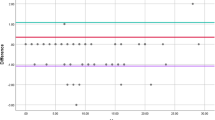Abstract
Aims
Research in to lower urinary tract symptoms (LUTS) in women in South Asia is hampered by lack of validated tools. Our aim was to validate the International Consultation on Incontinence Modular Questionnaire on Female Lower Urinary Tract Symptoms (ICIQ-FLUTS) from English to Tamil.
Method
After translation to Tamil, a validation study was carried out among women attending the gynecology clinic at District General Hospital-Mannar.
Results
Content validity assessed by the level of missing data was <2%. Construct validity was assessed by the ability of the questionnaire to identify patients with incontinence (n = 45) from controls (n = 93) using the incontinence score [patients = 7.7 standard deviation (SD) = 4.7, controls = 1.4 SD = 2.2, p < 0.001] and those with symptomatic anterior wall prolapse (n = 16) from controls (n = 93) using voiding symptoms score (patients = 4.8 SD = 2.3, controls = 0.3 SD = 0.8, p < 0.001). Internal consistency was assessed using Cronbach’s coefficient alpha score [0.80 (0.77–0.81)]. Test–retest reliability assessed by weighted kappa (κ) ranged from 0.73 to 0.87. Patients with incontinence (n = 30, pretreatment incontinence score = 7.9, SD = 4.9 versus posttreatment incontinence score = 3.3, SD = 3.1) and symptomatic anterior wall prolapse (n = 14, preoperative voiding symptoms score = 4.9 SD = 2.5 versus postoperative voiding symptoms score = 0.9 SD = 1.5) showed an improvement with treatment (Wilcoxon matched-–pairs signed-rank test p < 0.001 and p < 0.01, respectively). An incontinence score ≥ 3 (sensitivity = 86.7%, specificity = 78.4%) and a voiding symptoms score ≥ 3 (sensitivity = 87.5%, specificity = 96.2%) detected any form of incontinence and symptomatic anterior wall prolapse, respectively.
Conclusion
Tamil translation of ICIQ-FLUTS retained the psychometric properties of the original English questionnaire and will be an invaluable tool to detect LUTS among Tamil-speaking women.



Similar content being viewed by others
References
Pinnock C, Marshall VR. Troublesome lower urinary tract symptoms in the community: a prevalence study. Med J Aust. 1997;167(2):72–5.
Kupelian V, Wei JT, O’Leary MP, Kusek JW, Litman HJ, Link CL, et al. Prevalence of lower urinary tract symptoms and effect on quality of life in a racially and ethnically diverse random sample: the Boston Area Community Health (BACH) Survey. Arch Intern Med. 2006;166(21):2381–7.
Avery KN, Bosch JL, Gotoh M, Naughton M, Jackson S, Radley SC, et al. Questionnaires to assess urinary and anal incontinence: review and recommendations. J Urol. 2007;177:39–49. doi:10.1016/j.juro.2006.08.075.
Hashim H, Avery K, Mourad MS, Chamssuddin A, Ghoniem G, Abrams P. The Arabic ICIQ-UI SF: an alternative language version of the English ICIQ-UI SF. Neurourol Urodyn. 2006;25(3):277–82.
Jackson S, Donovan J, Brookes S, Eckford S, Swithinbank L, Abrams P. The Bristol Female Lower Urinary Tract Symptoms questionnaire: development and psychometric testing. Br J Urol. 1996;77(6):805–12.
Guillemin F, Bombardier C, Beaton D. Cross-cultural adaptation of health-related quality of life measures: literature review and proposed guidelines. J Clin Epidemiol. 1993;46:1417–32.
http://www.iciq.net/validationprotocol.htm. Accessed 29th Dec 2015.
Bryant FB, Yarnold PR. Principal-components analysis and exploratory andconfirmatory factor analysis. In: Grimm LG, Yarnold PR, editors. Reading andunderstanding multivariate statistics. Washington DC: AmericanPsychological Association; 1995. p. 99–136.
Haylen BT, de Ridder D, Freeman RM, Swift SE, Berghmans B, Lee J, et al. An International Urogynecological Association IUGA)/International Continence Society (ICS) joint report on the terminology for female pelvic floor dysfunction. Neurourol Urodyn. 2010;29(1):4–20.
National Institute of Health and Clinical Excellence. Clinical guideline no. 171. Urinary incontinence in women: management. Nov 2015.
European Association of Urology. 2015. Guidelines on Urinary Incontinence. http://uroweb.org/wp-content/uploads/20-Urinary-Incontinence_LR1.pdf. Accessed on 3rd Feb 2016.
Altman D. Practical statistics for medical research. London: Chapman and Hall; 1991.
Jelovsek J, Maher C, Barber MD. Pelvic organ prolapse. Lancet. 2007;369:1027–38.
Hannestad YS, Rortveit G, Sandvik H, Hunskaar S. A community-based epidemiological survery of female urinary incontinence: the Norwegian EPINCONT study. Epidemiology of Incontinence in the County of Nord-Trondelag. J Clin Epidemiol. 2000;53:1150–7.
Streiner DL, Norman GR, Cairney J. Health measurement scales a practical guide to their development and use. 5th ed. Oxford: Oxford University Press; 2015.
Tamanini JT, Dambros M, D’Ancona CA, Palma PC, Rodrigues Netto Jr N. Validation of the “International Consultation on Incontinence Questionnaire -- Short Form” (ICIQ-SF) for Portuguese. Rev Saude Publica. 2004;38(3):438–44 [Article in Portuguese].
Stavros A, Themistoklis G, Niki K, George G, Aristidis A. The validation of international consultation on incontinence questionnaires in the Greek language. Neurourol Urodyn. 2012;31:1141–4. doi:10.1002/nau.22197.
Celik DB, Beji NK, Yalcin O. Turkish adaptation of the short form of the pelvic organ prolapse/urinary incontinence sexual function questionnaire (PISQ-12): A validation and reliability study. Neurourol Urodyn. 2013;32:1068–73. doi:10.1002/nau.22369.
Duckett JRA, Tamilselvi A. Effect of tension-free vaginal tape in women with a urodynamic diagnosis of idiopathic detrusor overactivity and stress incontinence. BJOG. 2006;113:30–3.
Lemack GE. Use of urodynamics prior to surgery for urinary incontinence: how helpful is preoperative testing? Indian J Urol: J Urol Soc India. 2007;23(2):142–7. doi:10.4103/0970-1591.32065.
Fischer JE, Bachmann LM, Jaeschke R. A readers’guide to the interpretation of diagnostic test properties: clinical example of sepsis. Intensive Care Med. 2003;29:1043–51.
Acknowledgements
We wish to thank data collectors Dr. Bhathiya Mirando, Dr. GDD Premaratne, and Dr. Abdul Basith. We also acknowledge the efforts of Dr. K. Muhunthan and his team during the translation process and the gynecology ward and clinic staff of District General Hospital Mannar. This study was supported by the National Research Council of Sri Lanka (NRC Grant no. 16–086).
Publisher’s Note
Springer Nature remains neutral with regard to jurisdictional claims in published maps and institutional affiliations.
Author information
Authors and Affiliations
Corresponding author
Ethics declarations
Conflict of interest
None.
Rights and permissions
About this article
Cite this article
Ekanayake, C.D., Pathmeswaran, A., Nishad, A.A.N. et al. Translation and validation of ICIQ-FLUTS for Tamil-speaking women. Int Urogynecol J 28, 1875–1881 (2017). https://doi.org/10.1007/s00192-017-3316-5
Received:
Accepted:
Published:
Issue Date:
DOI: https://doi.org/10.1007/s00192-017-3316-5



